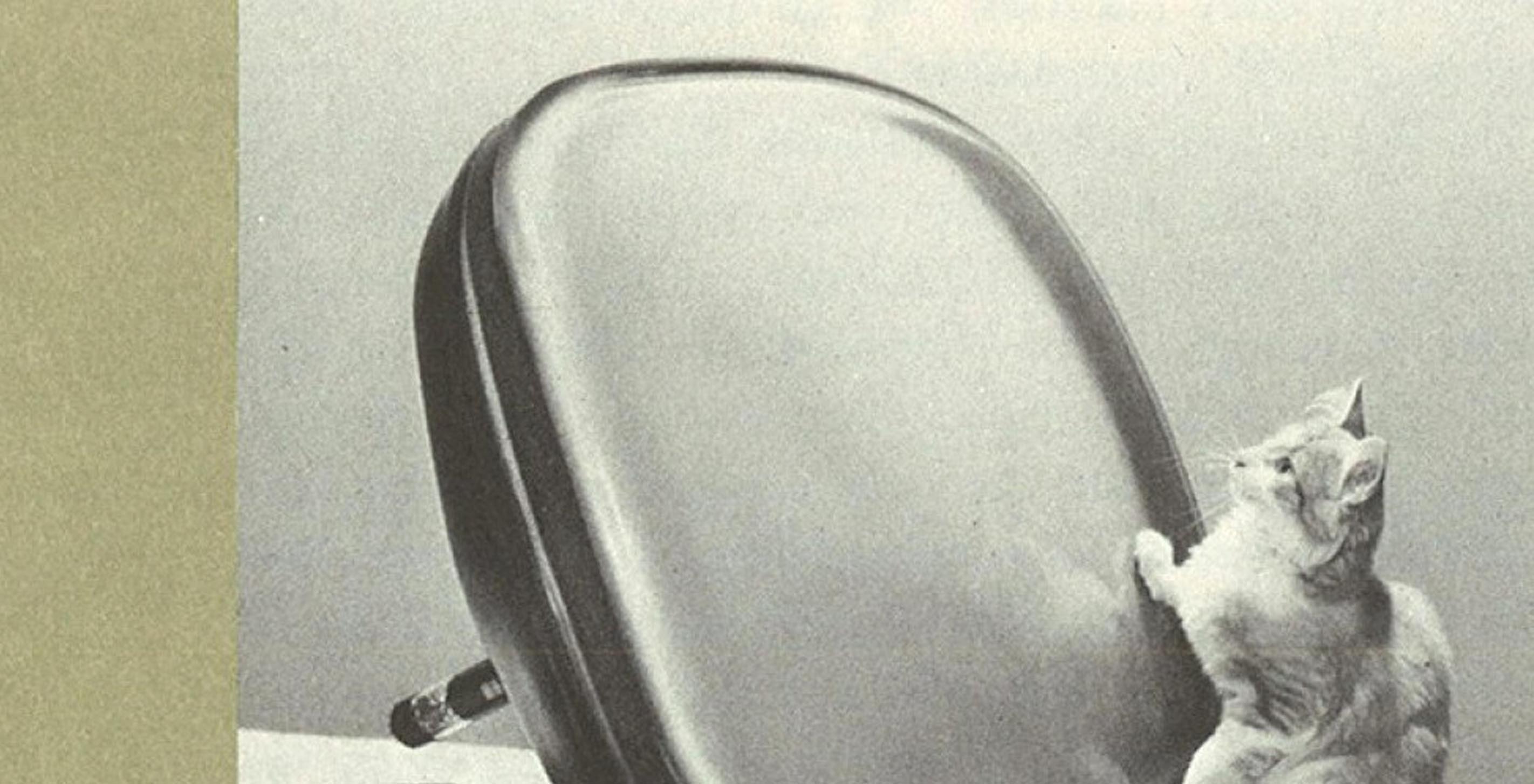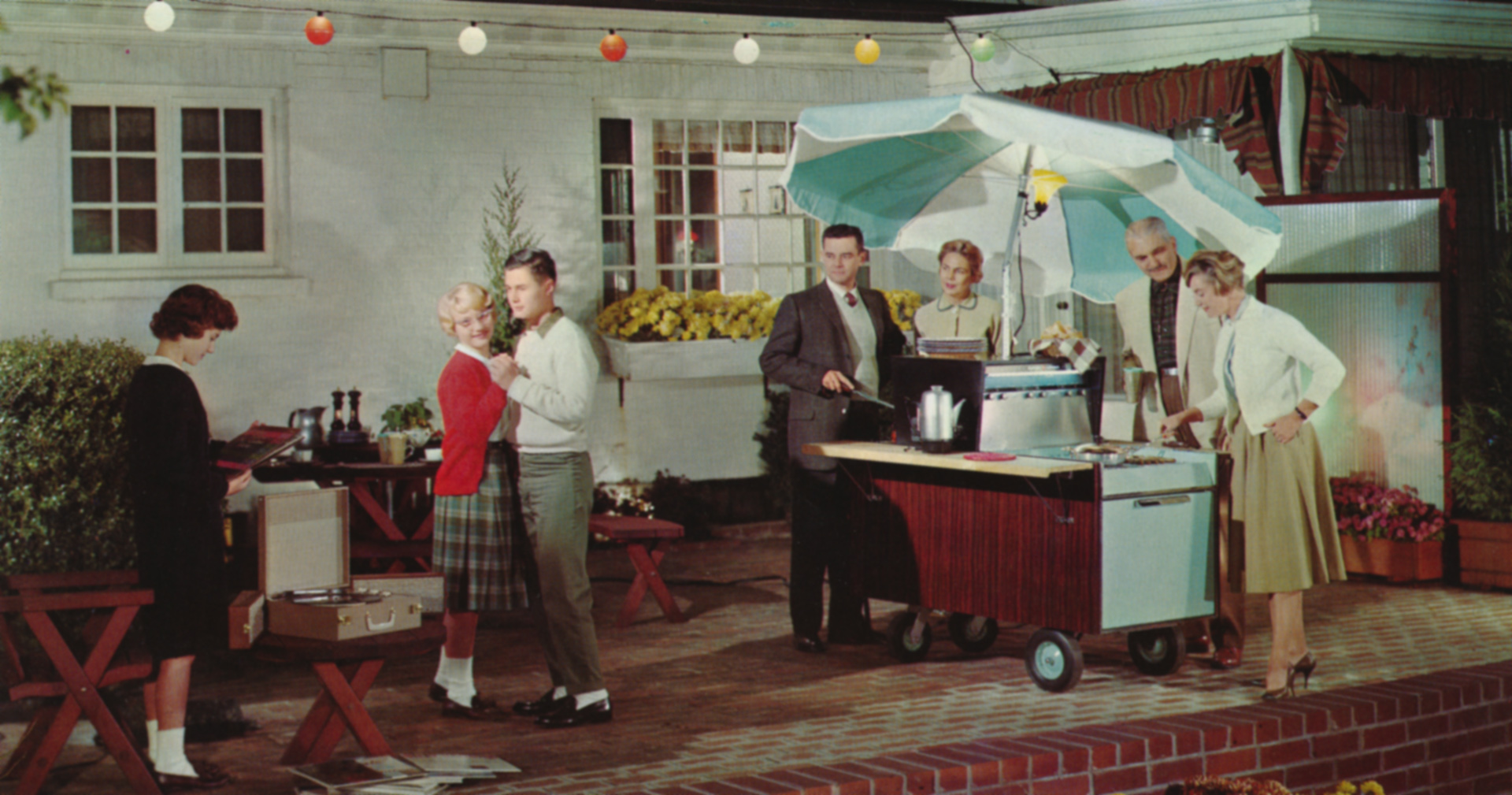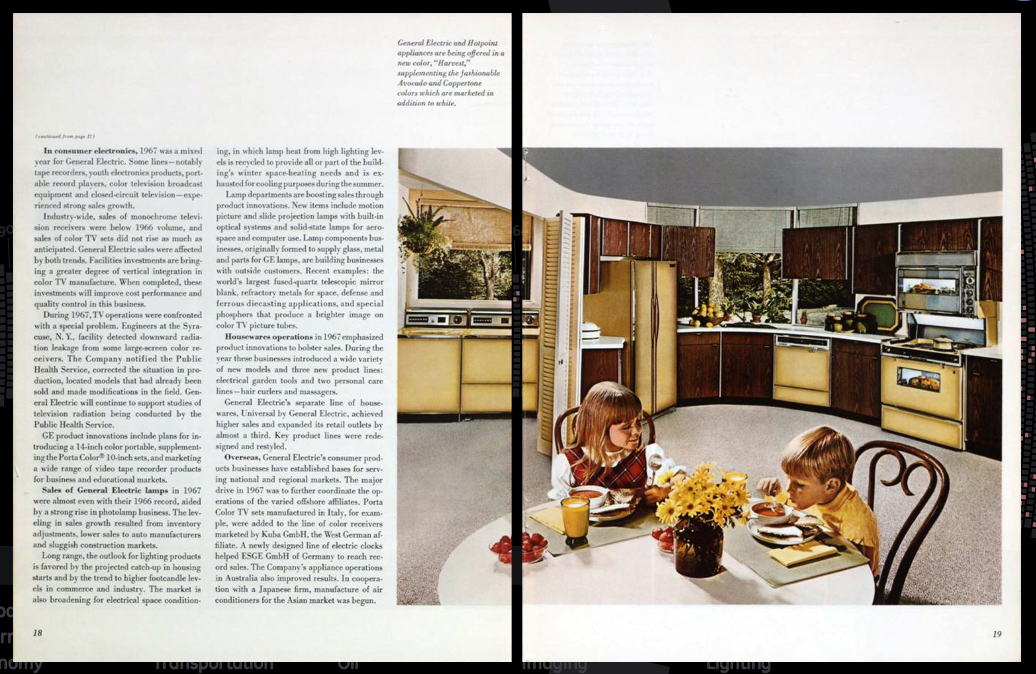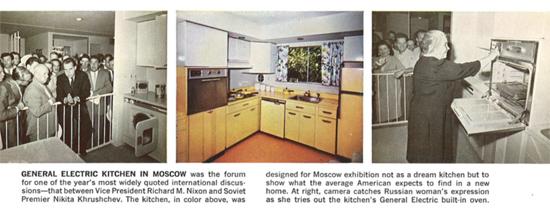

The layout depicts all 5,480 pages of reports in a single display. The 1892 report, just 18 pages long, is seen on the left, while the newly released 2011 report weighs in at 146 pages on the right. (With the exception of the front and back covers, we show “spreads” or pairs of pages together, just the way that you’d read them in the originals.)
Clicking on one of the terms on the lower left highlights all relevant mentions of that term across all of the pages. Selecting a highlighted page shows the text that surrounds each word, and clicking on the page displays the actual spread.
In addition to the terminology changes, we were also excited about seeing design trends, since annual reports are a kind of bellwether of graphic design. When viewing a cover, you can also move left or right to see each year one after another.
The collection reveals a fascinating history of not only GE as a company, but also the country as a whole. The reports directly address national and world events—economic depressions, world wars, the space race, energy crises—and the challenges they brought to the company, its investors, and its consumers. Reports from 1915 and 1944 mention GE’s production of war goods at the request of the government. The annual report of 1945 describes how GE provided parts for the atomic bomb, which has “…brought to mankind a potential source of power heretofore unavailable and almost inconceivable.” The 1973 report, reflecting on that year’s oil crisis, notes how “the energy challenge has several special facets of meaning for General Electric.”
When and how watchwords emerge is another piece of the story. “Technology” was commonly used beginning in the 1960s. The first mention of “Innovation” in 1949 pertains to the clock radio—“Nearly 1,000,000 sets of this popular postwar innovation have been produced”—but the term appears often, especially in chairman’s reports, from the 1980s on.
Even in its earlier years, GE was an international company, and the reports depict the rapid growth of its international businesses in later years. In the 1970s, the more modest “International” starts to lose ground to the all-encompassing “Global,” terminology that reaches notable frequency in the reports of the 2000s, as “globalization” became the word of the day.
Changing sensibilities also meant that words were used in different ways, and in some cases we decided to preserve these alternate uses. In the 1890s and through the first decades of the twentieth century, the term “economy” is used to describe the efficiency of processes, people, and machines rather than national and global fortunes. The 1894 report notes steps being taken to mitigate losses suffered in the panic of 1893: “Special attention has been given to the supervision of credits, economy of administration, and the improvement of factories…” Not until 1946 does a report stress that reducing coal and oil consumption in the production of electricity is of “tremendous importance to the national economy.”
On the visual front, black-and-white text and simple graphs give way to full-color photographs by mid-century. The 1945 report, which covers the company’s transition from wartime to peacetime production, is markedly longer than the wartime reports and is the first to include photographs.
In a number of instances, the sentence containing the keyword isn’t even the most interesting thing on the page. “Health” leads us to page 17 of the 1952 report, where a delightful kitten paws at the “first 27-inch aluminized picture tube.” (the same size as the flat panel monitors used in the development of this piece.) “Lighting” shows us the amazing “‘Partio Cart,’ a complete outdoor cooking center on wheels” along with party-goers in classic 1960 fashions.
“Wind” takes us to 1981, where a scientist works at a massive computer with a hood (p. 9) that makes one grateful for the portability of modern laptops. “Global,” as in “brutally Darwinian global marketplaces,” will lead you to page 4 of the 1991 report, but the real gem is CEO Jack Welch’s explanation of why he has been on a crusade to remove bureaucracy and layers from GE:
“Layers...insulate. They slow things down. They garble. Leaders in highly layered organizations are like people who wear several sweaters outside on a freezing winter day. They remain warm and comfortable but are blissfully ignorant of the realities of their environment. They couldn’t be further from what’s going on.”
Over the course of his leadership at GE, Welch turned the previously matter-of-fact chairman’s letters into spirited declarations of GE’s goals for the future.
Searching for the term “Appliances” provides a particularly amusing look at fashions and gender roles throughout the years. The term takes us to page 20 of the 1967 report, where we are introduced to appliances in the new yellow “Harvest” color, “supplementing the fashionable Avocado and Coppertone colors which are marketed in addition to white.”
In 1961, a Betty Draper-ish housewife pours her husband a cup of coffee and displays the “many other electrical servants the Company brings to the aid of homemakers.” (In 1976, on p. 11, a husband in bellbottom jeans is finally pouring himself his own damn cup of coffee.) “Appliances” also suggests GE’s global reach, even mid-century: in the 1959 report, p. 7 has photographs of Nixon and Khrushchev visiting the kitchen built by GE in Moscow. The caption notes that the kitchen was designed “not as a dream kitchen but to show what the average American expects to find in a new home.”
Later reports illustrate GE’s efforts to become a more diverse and global company. A search for “Technology” yields a statement about the company’s support of educational programs designed to attract women and minorities to engineering (1976, p. 26). People of color begin to emerge in photographs of employees at work and of consumers using GE products. In the 1950s and 1960s, women in the reports appear most often in the kitchen, making dinner and washing dishes; by the 1970s they are pictured running machines and heading divisions—and one, Gertrude Michelson, has joined the board of directors. Her retirement is noted in 2001 after twenty-six years of service; compare that board of directors (pp. 38-39) to the board her first year (1976, p. 25). The 2000s in particular reflect a concern with making products that benefit consumers around the world. Searching for “Cancer” brings up p. 29 in the 2011 report, which describes GE’s $1 billion commitment to improve cancer screening in under-served areas such as Saudi Arabia.
The piece allows users to discover these details while speaking to a larger story: how the history of GE has reflected the history of the United States. It shows how their inventions and innovations, from a better light bulb to a jet engine to an energy-saving refrigerator, both impact and are influenced by the changing lives and demands of American—and, increasingly, global—consumers.
(In a future post, we hope to add more details about how the piece was built. We had less than two weeks to go from working prototype—with thousands of unretouched scans—to production—with all 5,480 pages and over 5,000 text excerpts! Features were limited as a result, and the process of scanning, cleaning, and annotating all of the data took center stage. More later...)
We’d love to hear what you’re working on, what you’re curious about, and what messy data problems we can help you solve. Drop us a line at hello@fathom.info, or you can subscribe to our newsletter for updates.




